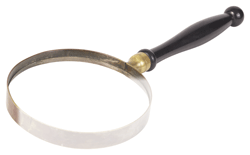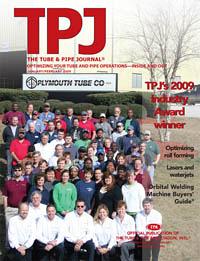- FMA
- The Fabricator
- FABTECH
- Canadian Metalworking
Categories
- Additive Manufacturing
- Aluminum Welding
- Arc Welding
- Assembly and Joining
- Automation and Robotics
- Bending and Forming
- Consumables
- Cutting and Weld Prep
- Electric Vehicles
- En Español
- Finishing
- Hydroforming
- Laser Cutting
- Laser Welding
- Machining
- Manufacturing Software
- Materials Handling
- Metals/Materials
- Oxyfuel Cutting
- Plasma Cutting
- Power Tools
- Punching and Other Holemaking
- Roll Forming
- Safety
- Sawing
- Shearing
- Shop Management
- Testing and Measuring
- Tube and Pipe Fabrication
- Tube and Pipe Production
- Waterjet Cutting
Industry Directory
Webcasts
Podcasts
FAB 40
Advertise
Subscribe
Account Login
Search
Continuous improvement for roll forming - Part I
Measuring capacity and utilization
- By Andy Allman
- March 10, 2009
- Article
- Roll Forming
Editor's Note: This article is the first of a two-part series.
Can you find a hidden roll former or tube/pipe mill in your shop? It is on your plant floor, but not necessarily in plain sight. Most roll formers and many mills produce at a rate far below their true potential. Rather than seek out this hidden capacity, many companies simply purchase more machines and expand their facilities. While this approach certainly works, it may not be the best use of the company's resources. A 1999 study by Rohm and Haas Corp. determined that developing the capacity of existing equipment and facilities was 10 times less expensive than building new capacity.1
By using a simple performance metric, overall equipment effectiveness (OEE), and by embracing the concept of continuous improvement, you can dramatically enhance the productivity, quality, and reliability of your existing equipment.
Continuous Improvement Methods
Continuous improvement is the ongoing enhancement of products, processes, and services through incremental and radical steps. Several approaches to continuous improvement exist. Each system has unique aspects and different emphases, but all share the same basic assumptions: An organization has limited capital and management time, and these resources should be put to the very best use to optimize productivity and quality. Improvement efforts are cyclical and never-ending.
Deming Cycle. The Deming cycle (see Figure 1) was originally conceived by Walter Shewhart in the 1930s. It was later popularized by W. Edwards Deming and adopted by many Japanese manufacturers in the 1950s. The approach involves the following steps:
- Plan. Examine the current situation, gather data, identify problems, and develop solutions.
- Do. Test the plans on a trial basis (minimizing disruption), and collect resulting data.
- Study. Determine whether the plan achieved the desired results. Modify the plan if needed.
- Act. Implement the plan throughout the organization.
DMAIC. The American Society for Quality defines DMAIC as "a data-driven quality strategy for improving processes and an integral part of a Six Sigma quality initiative."2
DMAIC is an acronym for the following steps:
- Define. Clearly define the problem to be solved. Define the current state as well as the expected results after the improvement project.
- Measure. Define the questions to be answered, what form the answers will be in, where the data will come from, and how to collect the information with minimal effort and lowest chance of errors.
- Analyze. Focus on why defects or errors occur. Identify the root causes of the problem. Conduct experiments to confirm hypotheses in a statistically valid form.
- Improve. Generate multiple solutions via brainstorming. Evaluate each idea and select the most promising solution. Confirm the success of the solution relative to the expected results; refine if necessary.
- Control. Put a system in place to maintain the results. Establish necessary policies, procedures, and training. Develop controls to ensure that key variables remain within the acceptable range.
FADE. The FADE model is similar to the Deming and DMAIC systems and is widely used in health care and many branches of the government. FADE stand for focus, analyze, develop, and execute.
All of these systems share several common themes:
- Continuous improvement is a process of optimization.
- You must find the most efficient method of identifying problems, finding root causes, developing and validating solutions, and implementing the solutions in a sustainable fashion.
- When one project comes to a successful conclusion, the process starts over with the next most pressing issue.
- A regular review of a few key performance metrics is a crucial ingredient in monitoring performance and identifying problem areas.
Measuring Performance and Capacity Using OEE and TEEP
Overall equipment effectiveness (OEE) measures how effectively a machine operates during the time it is scheduled to run.
Three main components of OEE are availability, speed, and yield (seeFigure 2). Availability is the ratio of machine run time to the scheduled production time. Speed is the ratio of actual running speed to the machine's maximum speed. Yield is the ratio of good material produced to the total material used.
Each of these components is expressed as a percentage, and the product of all three is the OEE. Some single-profile tube mills with coil accumulators might approach 100 percent OEE, whereas most roll forming lines run somewhere between 20 percent and 65 percent OEE.
When reviewing setup time on roll forming machines, you should consider the equipment's limits, operator's performance within those limits, and the efficiency of the production schedule. For example, some roll forming lines are designed for quick coil and tooling changeover and some are not. These factors are beyond the operator's control. Likewise, a wasteful production schedule—one that has several short runs of a particular product during one shift, rather than one long run—also is beyond the operator's control. It is necessary to account for such factors when evaluating an operator's performance.
PPM, FPM, and Takt. In many manufacturing environments, the production rate is based on the number of parts produced while the machine is running, and the output is measured in parts per minute (PPM). Regarding roll forming, it may be more helpful to consider the average running speed of the machine in feet per minute (FPM). Unfortunately, the average FPM does not provide an honest measurement of performance. The roll former's maximum speed depends on the product and part length being run at the time. Press stroke rates may limit the maximum line speed when running short parts. Handling problems may limit the speed when running very long parts.Figure 3illustrates the relationship between maximum speed and part length on many roll forming lines.
In cases where the roll former is feeding parts into a lean manufacturing cell, the running speed may be reduced to correspond to the takt time of the cell. Takt is the heartbeat of a lean manufacturing operation and typically is measured in seconds. It is defined as the available production time divided by the customer demand for that period. Therefore, the maximum speed used to calculate the speed percentage is based on the takt rate.
OEE Example. To calculate OEE, first determine the amount of time the machine is scheduled to run. If the operator has one hour of break time (30 minutes for lunch and two 15-minute coffee breaks) during an eight-hour shift, the available time is 420 minutes. Next, determine how long the machine actually ran. In this example, the machine ran a total of 153 minutes (see Figure 4).
Other relevant data for this example:
Average speed for this shift: 483 FPM.
Average speed without stoppages: 525 FPM
Material run: 74,000 ft.
Scrap produced: 216 ft.
OEE % = Availability % Speed % Yield %
Availability = (Run time)/(Available time) = (153)/(420) = 36%
Speed = (Actual rate)/(Max. rate) = (483)/(525) = 92%
Yield = (Good footage)/(Total footage) = (73,784)/(74,000) = 99%
OEE = 0.36 0.92 0.99 = 33%
Is an OEE of 33 percent considered to be good, bad, or somewhere in the middle? It doesn't matter. You don't use OEE to take a single measurement; it's a tool for making a series of measurements to monitor the line's effectiveness over time (see Figure 5). The initial OEE provides a baseline to measure the overall effectiveness of process changes.
TEEP Example. Total effective equipment performance (TEEP) is similar to OEE, except it considers the total clock or calendar time available. TEEP includes all 24 hours and is a more direct measurement of the possible capacity of the equipment.
TEEP % = Asset utilization % Speed % Yield %
Asset utilization = (Run time)/(Total time) = (153)/(1,440) = 11%
Speed = (Actual rate)/(Max. rate) = (483)/(525) = 92%
Yield = (Good footage)/(Total footage) = (73,784)/(74,000) = 99%
TEEP = 0.11 0.92 0.99 = 10%
Notes
- Robert C. Hansen, Overall Equipment Effectiveness (New York, N.Y.: Industrial Press, 2002), p. 19.
- The American Society for Quality – Quality Glossary, www.asq.org/info/glossary.
About the Author
Andy Allman
12180 Prichard Farm Road
Maryland Heights, MO 63043
800-334-5213
About the Publication
subscribe now

The Tube and Pipe Journal became the first magazine dedicated to serving the metal tube and pipe industry in 1990. Today, it remains the only North American publication devoted to this industry, and it has become the most trusted source of information for tube and pipe professionals.
start your free subscription- Stay connected from anywhere

Easily access valuable industry resources now with full access to the digital edition of The Fabricator.

Easily access valuable industry resources now with full access to the digital edition of The Welder.

Easily access valuable industry resources now with full access to the digital edition of The Tube and Pipe Journal.
- Podcasting
- Podcast:
- The Fabricator Podcast
- Published:
- 04/16/2024
- Running Time:
- 63:29
In this episode of The Fabricator Podcast, Caleb Chamberlain, co-founder and CEO of OSH Cut, discusses his company’s...
- Trending Articles
Team Industries names director of advanced technology and manufacturing

Orbital tube welding webinar to be held April 23

Chain hoist offers 60-ft. remote control range

Push-feeding saw station cuts nonferrous metals

Corrosion-inhibiting coating can be peeled off after use

- Industry Events
16th Annual Safety Conference
- April 30 - May 1, 2024
- Elgin,
Pipe and Tube Conference
- May 21 - 22, 2024
- Omaha, NE
World-Class Roll Forming Workshop
- June 5 - 6, 2024
- Louisville, KY
Advanced Laser Application Workshop
- June 25 - 27, 2024
- Novi, MI



























